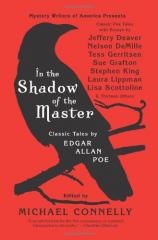In the Shadow of the Master: Classic Tales by Edgar Allan Poe
Review
In the Shadow of the Master: Classic Tales by Edgar Allan Poe
If you want to understand America through its literature, it is
as essential to read Edgar Allan Poe as it is to read Melville,
Twain or Fitzgerald. For America has always been a land marked by a
belief in our own exceptionalism. America was the “shining
city on the hill,” a positive place of eternal goodness and
promise. Poe told us to hold off a bit on the laurels. His words
took us deep into the darkness and forced us to look whether we
liked it or not. He was the first great American writer to teach us
that maybe stories don’t all have happy endings and
redemption doesn’t always come with the dawn.
This year marks the 200 anniversary of Poe’s birth. But,
as Michael Connelly points out in IN THE SHADOW OF THE MASTER,
“happy” is hardly a word people use in the same
sentence as Poe. Irregardless, the Mystery Writers of America
decided to throw a sort of a birthday party for the dark genius by
gathering 16 of his classic short stories and poems along with
essays from 20 of today’s greatest practitioners of the genre
Poe helped create, including Connelly, Stephen King, Lawrence
Block, Sara Paretsky, Laura Lippman and Nelson DeMille.
The result is a wonderfully accessible and lively volume that
functions well as both a gateway to Poe for the new reader and a
refresher course for those who have not read him since being forced
to in high school.
Poe is probably as well known now as a symbol of the macabre,
for his booze- and drug-dominated lifestyle and for his bizarre
unexplained death at the age of 40 as he is for his actual work. He
is the only American author to have an NFL football team named
after his most famous creation --- a fact that might be as bizarre
as his death.
Well before anybody ever dreamed of “Celebrity
Rehab,” Poe definitely lived his short life on the edge. And
150 years after his death, as Lippman points out here, who else but
Poe has 20 theories circulating about how he died? He was found
delirious on the streets of Baltimore, wearing clothes not his own.
He died soon thereafter, unable to explain what happened to
him.
Baltimore native Lippman’s essay is one of the things that
makes this volume so much fun. Rather than a dry academic analysis,
the contributors often tell us how they discovered Poe’s
work. Several cite the influence of Roger Corman’s B-movie
horror flicks, and one, DeMille, offers a hilarious story about
being trapped in a Long Island graveyard at dusk at the age of 11
after seeing Phantom of the Rue Morgue. Lawrence Block
explains how he uniquely figured out a way to lift the curse, not
cask, of Amontillado to finally win an Edgar Award, which is the
writing prize the Mystery Writers of America bestows each year.
Yet it is the words of Poe himself that still astonish. Not only
do the stories hold up, but the shock they provide you as an adult
is far different from the thrill you might have experienced as a
teenager.
Poe was a revolutionary writer, a true innovator. He invented
the detective novel. His character Dupin was what all fictional
detectives are based on, according to no less an expert than Sir
Arthur Conan Doyle. As King points out here, “The Tell-Tale
Heart” is the first story about a criminal sociopath. And 16
years before Freud was born, Poe was exploring the topic of dual
personalities in “William Wilson” and using an
unreliable narrator in “The Black Cat.”
Poe was not just writing stories; he was writing about
psychology before the field even existed. He was also the first
well-known American to try to make a living as a writer. For those
of us who have followed in his footsteps on that lonely path to
poverty, that might explain his need for a drink on occasion. Poe
made a grand total of $9 for his most famous work, “The
Raven.” I would imagine the Baltimore football franchise
makes considerably more decked out in their purple and black
costumes.
But Poe knew what all good writers know: it is not about the
bling, it is about the work. So Poe used words as a sledgehammer to
create claustrophobic tales filled with existential dread, horror
and death. Every word contributes to the tension, darkness and
madness. Like “A Descent into the Maelstrom,” the
reader is helplessly carried along to an unforgettable climax.
“I will read, and you shall listen; --- and so we will
pass away this terrible night together,” a character gently
says in “The Fall of the House of Usher.” Despite
living in an age when Hollywood grinds out even more graphic
slasher movies each year to shock the young and bored, nothing is
quite as scary as reading Poe alone, perhaps in a strange hotel
room, far from home. Connelly had that experience while researching
one of his novels in Washington, D.C and was literally scared out
of his bed. He writes,
“I’d let him take me to a world of dark imagination,
where common things become uncommon, where the routine becomes the
ghastly unexpected, where a slamming door becomes a shot in the
dark.”
Poe wrote when America was in the early stages of pushing
westward on the road to an Empire that promised universal good. He
demanded that we look inside and face the darkness.
King confesses in his essay that the most common question he is
asked by people is what scares him in fiction. His answer is
“The Tell-Tale Heart” by Poe. King writes, “Here
is a creature who looks like a man but who really belongs to
another species. That’s scary. What elevates this story
beyond merely scary and into the realm of genius, though, is that
Poe foresaw the darkness of generations far beyond his own.”
That says it best.
In his fevered dreams and tortured soul, Poe understood
something about the human heart that future generations of American
writers are still seeking to explore and replicate in their work.
But Poe will always be the master. IN THE SHADOW OF THE MASTER
deserves a place on every bookshelf.
Reviewed by Tom Callahan on January 22, 2011





